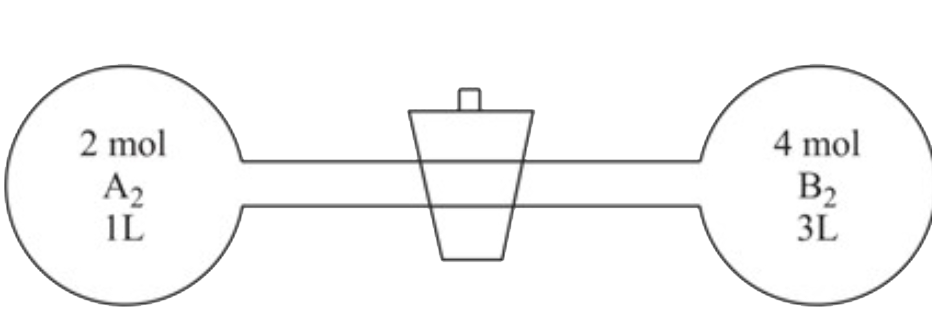Two substance A2(g) and B2(g) are allowed to react to form either of A2B2(l),A2B4(g) or both depending on relative amount.
Answer the following the following question, if 75 g A2 and 200gB2 are mixed and no reactant is left.
[Given :At mass of A =25 , B=50]
What is the volume of all the gases present in the mixture after completion of reaction at 760 mm of Hg and 273∘ C?
67.2 L
44.8 L
22.4 L
11.2 L
The correct Answer is:C
Step by step video, text & image solution for Two substance A_(2)(g) and B_(2)(g) are allowed to react to form either of A_(2)B_(2)(l), A_(2)B_(4)(g) or both depending on relative amount. Answer the following the following question, if 75 g A_(2) and 200g B_(2) are mixed and no reactant is left. [Given :At mass of A =25 , B=50] What is the volume of all the gases present in the mixture after completion of reaction at 760 mm of Hg and 273^(@) C? by Chemistry experts to help you in doubts & scoring excellent marks in Class 11 exams.
Topper's Solved these Questions
- BOOK - GRB PUBLICATIONCHAPTER - MOLE CONCEPT, STOICHIOMETRY & CONCENTRATION TERMSEXERCISE - Comprehension#771videos
MOLE CONCEPT, STOICHIOMETRY & CONCENTRATION TERMS
- BOOK - GRB PUBLICATIONCHAPTER - MOLE CONCEPT, STOICHIOMETRY & CONCENTRATION TERMSEXERCISE - Comprehension#781videos
MOLE CONCEPT, STOICHIOMETRY & CONCENTRATION TERMS
- BOOK - GRB PUBLICATIONCHAPTER - MOLE CONCEPT, STOICHIOMETRY & CONCENTRATION TERMSEXERCISE - Comprehension#751videos
MOLE CONCEPT, STOICHIOMETRY & CONCENTRATION TERMS
- BOOK - GRB PUBLICATIONCHAPTER - ISOMERISMEXERCISE - SUBJECTIVE TYPE67videos
ISOMERISM
- BOOK - GRB PUBLICATIONCHAPTER - NOMENCLATURE AND CLASSIFICATIONEXERCISE - Subjective Type24videos
NOMENCLATURE AND CLASSIFICATION
Similar Questions
A2+2B2→A2B4and32A2+2B2→A3B4
Two substance A2&B2 are allowed to react completely to from A2B4&A3B4 mixture of leaving none of the reactants. Using this information calculate the composition of final mixture when mentioned amount of A2&B2 are taken.
(i) If 54 moles of A2&2 moles of B2 is taken
(ii) If 72 moles of A2&6 moles of B2 is taken
(iii) If 4 moles of A2&6 moles of B2 is takenView SolutionSubstance A2B(g) can undergo decomposition to form of set of products :

if the molar ratio of A2(g) to A(g) is 5:3 in a set of product gases, then energy involved in the decomposition of 1 mole of A2B is :View Solution
Knowledge Check
- Question 1 - Select One
Two substance A2(g) and B2(g) are allowed to react to form either of A2B2(l),A2B4(g) or both depending on relative amount.
Answer the following the following question, if 75 g A2 and 200gB2 are mixed and no reactant is left.
[Given :At mass of A =25 , B=50]
Now A2B4 is transferred to another container completey . At high temperature it is completely dissociated in its gaseous elements A2 and B2 . Find average molecular weight of gaseous mixture:A1253B2503C125D250 - Question 2 - Select One
In a closed vessel, 5 moles of A2(g) and 7 moles of B2 (g) are reacted in the following maner,
A2(g)+(3B2(g)→2AB3(g)
What is the total number of moles of gases present in the container at the end of the reaction?A22/3B7/3C14/3D8/3 - Question 3 - Select One
For the reaction A(g)⇔B(g)+C(g)
AKp=α3PBKp=α2(Kp+P+1)CKp=α2(Kp+P)DKp=α2(KP+PP)

When A2andB2 are allowed to react, the equilibrium constant of the reaction at 27∘C is found (KC=4).A2(g)+B2(g)⇔2AB(g)
What will be the equilibrium concentration of AB?View SolutionTe yield of product in the reaction
A2(g)+B2(g)⇔2AB(g),ΔH=+veView SolutionIn a reaction A2(g)+4B2(g)⇔2AB4(g),ΔH<0. The formation of AB4 is not favoured by
View SolutionSubstance A2B(g) can undergoes decomposition to form two set of products :

If the molar ratio of A2(g) to A(g) is 5:3 in a set of product gases, then the energy involved in the decomposition of 1 mole of A2B(g) is :View SolutionSubstance A2B(g) can undergoes decomposition to form two set of products :

If the molar ratio of A2(g) to A(g) is 5:3 in a set of product gases, then the energy involved in the decomposition of 1 mole of A2B(g) is :View Solution

